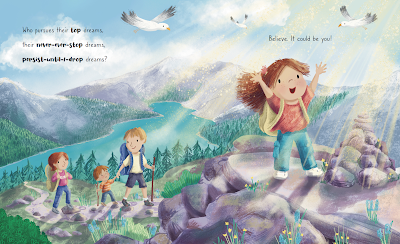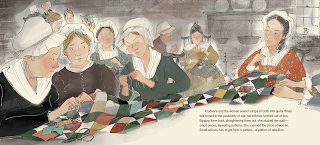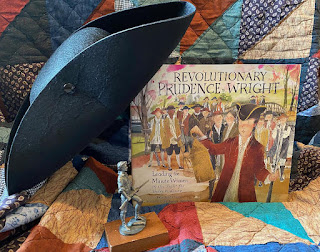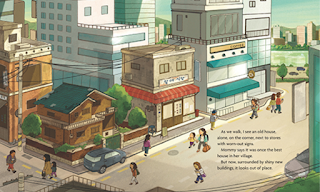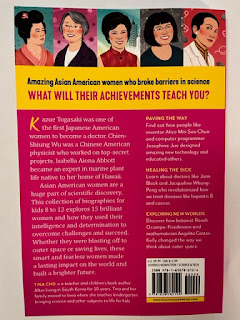Most of my writing and illustrating colleagues in the children’s book publishing world have been in this same spot . . . when your work-life balance is temporarily out of whack and weighted far too heavily to one side. Too many deadlines or marketing activities for an upcoming publication, and your work hours take over your free time. (Your family and friends wonder when you will come up for air!) On the flip side, there are times that writing, or illustrating must take a back seat to other commitments. Important activities such as helping family members, unexpected travel, group project commitments (you can’t let others down)—all these things and more can eliminate dedicated time for individual projects. It can be frustrating . . .but I have found ways to keep moving forward by focusing on a few things I can manage to squeeze in when I don’t have either time or the head space to write.
Wednesday, March 30, 2022
4 Ways to Get Back on Track When Your WORK-LIFE Balance is Off-Kilter by Eileen Meyer
Most of my writing and illustrating colleagues in the children’s book publishing world have been in this same spot . . . when your work-life balance is temporarily out of whack and weighted far too heavily to one side. Too many deadlines or marketing activities for an upcoming publication, and your work hours take over your free time. (Your family and friends wonder when you will come up for air!) On the flip side, there are times that writing, or illustrating must take a back seat to other commitments. Important activities such as helping family members, unexpected travel, group project commitments (you can’t let others down)—all these things and more can eliminate dedicated time for individual projects. It can be frustrating . . .but I have found ways to keep moving forward by focusing on a few things I can manage to squeeze in when I don’t have either time or the head space to write.
Wednesday, March 23, 2022
THIS COULD BE YOU: Craft Chat with Cindy Williams Schrauben and Book Review by Kathy Halsey
It's such fun to help writer friends celebrate their debut books. Like me, you may know of Cindy through her work over the years at ReFoReMo, which focused on mentor texts every March. Cindy had the Herculean task of organizing the picture book mentor texts by category or subject for the Facebook page files. After her years helping fellow picture book writers with comparative titles and mentor texts, it's so satisfying to feature Cindy Williams Schrauben with her own debut!
Book Review of This Could Be You
Educators and librarians, add this to your SEL, growth-mindset collection. Parents and grandparents, share as a fun read aloud with your children or grandchildren. This uplifting picture book from Cardinal Rule Press celebrates myriad of ways children can explore their world, dig into their passions, and help others.
This Could Be You features avocations and careers traditionally explored for the K-second grade band, as well as other choices not as commonly known for the younger set. Readers are encouraged to see themselves as gardeners, farmers, police, teachers, along with writers and activists. The bright, engaging illustrations by Julia Seal ensure inclusivity as people of color, women, and the differently abled are included. Lyrical, rhythmic verse and internal rhyme make this a bouncy romp of possibilities enticing children to imagine who they could be.
This Could Be You by debut author Cindy Williams Schrauben and illustrator Julia Seal will be released April 1, 2022.
Craft Chat with Cindy Williams Schrauben
Kathy: I know you’re a poet, but I’ve not seen the internal rhyme structure used as uniquely as you do in This Could Be You. Did early drafts begin this way? Did you suggest that the rhyme be bolded as an art note or did the art director suggest that?
Cindy: Actually, I used Give Me Back My Bones by Kim Norman as a mentor text. The first time I heard that fun rhyme scheme I knew I wanted to try it. Thanks, Kim. The format didn’t change, but early drafts were much different. The original title was Why Not You – thankfully that changed because a picture book with that title (written by an NFL quarterback and his wife) debuted this month.
Bolding and hyphenating the phrases was my idea. I played around with other options such as italics before settling on this combination. Because many of the sentences are structured unconventionally, I wanted kids to realize the importance of stressing those phrases. I was thrilled when my seven year old grandson read it correctly right away.
Kathy: Your back matter focuses on changes readers can make to have a growth mindset and how parents/caregivers can engage young readers to think more deeply about their social emotional learning. Was this an add-on or an integral part of how you envisioned this book?
Cindy: I subbed This Could Be You with this back matter. The main text is important, but I wanted to include supplemental information for adults that will help them to adjust their own perspectives and tweak their everyday vocabulary, empowering their families/students with a growth mindset. It was always my hope to create a book that would have this kind of enduring impact.
Kathy: Tell us a bit about your journey to become a published author. What was surprising? Unexpected?
Cindy: There have been lots of surprises along the way. I had no clue how trying and long the journey would be, BUT I am so grateful that I was able to persevere with the help of the amazing kidlit community. The generosity and camaraderie is unlike anything I’ve dealt with. Another surprise is playing out right now – it is easy to think that once you get a book deal, you’re set. In reality, the marketing process has required a great deal of time and energy.
I was also blessed with a surprise after the book was printed. The reverse side of the jacket features a 27” x 11” poster – I love it.
Kathy: I’m proud to be a member of your “street team” (folks who help spread the word about your debut). What are all the pieces, parts of your marketing campaign? How did your publisher, Cardinal Rule Press, help in this effort?
Cindy: Thank you! I couldn’t do this without my team. There are so many aspects to the marketing process. The key for me was finding ways to connect with my audience in a meaningful way – providing them with helpful content. I am lucky in that my book has a clear theme – educating people about a growth mindset. I did lots of research regarding marketing a picture book, but ultimately had to pare my ideas down to those efforts that would be both effective and enjoyable for me – otherwise, I would have gone crazy. If you follow my social media you will see lots of silly things I have done like making felted bees, creating a six-sided puzzle with pages from my book, and painting a huge rocket photo booth. Will these things make a big difference? Maybe not, but it was fun and that is important, too.
I couldn’t be happier with the support and guidance I’ve gotten from Cardinal Rule Press. They offer Master Classes, Office Hours, and suggested timelines as well as extensive marketing efforts. The founder, Maria Dismondy and her team are phenomenal.
Kathy: What are you working on now?
Cindy: I am always working on several stories at once. I am a pantser for sure – I roll with whatever feels right at the moment. I never want to make my writing feel like work. I am looking for ways to give back to the writing community as soon as things calm down (after my launch). Besides that and marketing, I am working on an initiative I call, Partners in Literacy. It is a program in which businesses can sponsor my school visit by purchasing a book for each child from a local indie. I hope to kick it off soon. There is info on my website.
Cindy Williams Schrauben lives in Michigan where she writes books for kids that range from truly serious to seriously silly. Before embarking on this path, she held positions as a preschool administrator, teacher, and assistant director of a children’s museum -- always striving to empower kids. When not writing or honing her craft, Cindy might be found dissecting her grandsons’ shenanigans for story ideas, reading on the floor in the bookstore, or eating ice cream… ideally all at once.
You can connect with Cindy at www.cindyschrauben.com or www.direct.me/cindywilliamsschrauben
Wednesday, March 16, 2022
Guest post: The Power of Imagery by Beth Anderson
Beth Anderson is back with us this time with another new picture book biography--Revolutionary Prudence Wright: Leading the Minute Women in the Fight for Independence, published by Calkins Creek, February 1, 2022. Beth shares her expertise, this time, in the area of imagery.
I’m a big fan of imagery – as a teacher, reader, and writer!
Imagery elevates the narrative, invites lyricism, strengthens theme, and
enhances heart. It’s a much used tool in my writer’s toolbox.
What exactly is imagery? Literarydevices.net defines it this
way:
Imagery is a literary device
that refers to the use of figurative language to evoke
a sensory experience or create a picture with words for a reader. By utilizing
effective descriptive language and figures of speech, writers appeal to
a reader’s senses of sight, taste, smell, touch, and sound, as well as internal
emotion and feelings. Therefore, imagery is not limited to visual
representations or mental images, but also includes physical sensations and
internal emotions.
Wow! Makes you just want to pour it on! But…imagery should
be subtle and not waste words. It should flow naturally and not feel contrived.
It should be sprinkled, like spices or herbs, to enrich what’s already
there.
In AN INCONVENIENT ALPHABET, I placed “battle” words
throughout to reinforce the idea that a revolution is more than a military
battle. “Breaking free of old ways” involves many areas of our lives.
The imagery in TAD LINCOLN’S RESTLESS WRIGGLE was also in
word choice. I powered the story with his wriggle as an irrepressible force of energy.
This doesn’t rob him of his dignity or impose a negative judgement for the
reader.
In SMELLY KELLY AND HIS SUPER SENSES, I interwove super-hero
imagery with details, words, and phrases. Sensory images abound for this
character with super senses.
In LIZZIE DEMANDS A SEAT!, imagery went deeper than word
choice. Footsteps echo through the story—a ticking clock, heartbeats, a stranger’s
approach, and, in the culmination of the heart thread, others stepping up to
carry forward social justice.
I think everything I write uses alliteration, onomatopoeia,
and sensory language. But when a story lends itself to using a metaphor, that’s
something special! And REVOLUTIONARY PRUDENCE WRIGHT invited the opportunity…
When I dive into a story, I try to think about the different
angles I might tell it from, or look for something in the setting that might
ring through the story. Then I consider those ideas along with themes and the
heart thread, and I start generating word lists that I can draw from as I
write. This preps my brain and frames my thinking.
As I researched Prudence Wright, I collected words and phrases in my spiral, beginning with those related to revolution and independence. One of the first items I wrote was the Thomas Paine quote that starts the story: “These are the times that try men’s souls.” I saw it as a truth, but also as leaving out women. Thus, the addition of “and women’s” seemed to fit Prudence and her story perfectly. That’s where her voice first emerged.
I created a word bank of military and revolution words. I
wanted to show that the women’s actions were as powerful as the men’s.
Since the main event occurs in April, one of my first ideas
for the “big picture” imagery of a metaphor was that of spring, gardens, and
planting the seeds of independence. But, though it fit the home front idea, I
knew immediately that it didn’t fit the concepts and had the wrong tone.
One of my Pepperell contacts had shared photos of a few
artifacts from Prudence’s life, including her love box and lantern that could
easily be used in the story. Prudence designed and created beautiful quilts,
but there were no pictures available. Learning about and seeing personal items
from my subject’s hands connected me in a special way. Could I use them in the
story?
I listed words associated with a lantern and fire, and I also
jotted down words about quilts. Could either serve as a metaphor? The idea of
quilts really fit the story, not only because Prudence made them, but because
they are from the hands, often involve a community of women, are made from
remnants of lives, and handed down as family history.
Metaphors fall into place as I write. Lizzie’s footsteps came through during the revision process when I realized I had the pieces and just needed to connect them better. Prudence’s story was about women bound together as community and breaking old patterns. And as I worked to transition scenes, I realized that their boycott actions were like scraps for a quilt, of little consequence until joined with others. Organizing the pattern of resistance was like the larger design of a quilt. Suddenly the quilt idea popped and became powerful! And paired with the scene of the women quilting, it emphasizes that this rebellion is coming from homes. Yahoo! Don’t you just love it when it all comes together!
Illustrator Susan Reagan brought back the quilt image in the art at the end, reflecting the simile on the page, “The women weren’t organized and trained like the men, but they were bound together, like blocks of a quilt.” Use of imagery also opens up potential with illustration, and the merging of art and text tightens and strengthens the story.
Though we think of imagery as evoking images, as the
definition above says, imagery is more than visual or sensory. It touches us
internally, emotionally. No wonder it’s so powerful!
Thank you, Beth! I love this new story and the image of the quilt since my mom quilts. I love how you find unique angles on all your picture book subjects.
You can find more about Beth here! And more blog posts from Beth here and here.
 Bio: Beth Anderson, a former English as a Second Language teacher, has always marveled at the power of books. With linguistics and reading degrees, a fascination with language, and a penchant for untold tales, she strives for accidental learning in the midst of a great story. Beth lives in Loveland, Colorado where she laughs, ponders, and questions; and hopes to inspire kids to do the same. She’s the award-winning author of TAD LINCOLN’S RESTLESS WRIGGLE, “SMELLY” KELLY AND HIS SUPER SENSES, LIZZIE DEMANDS A SEAT!, and AN INCONVENIENT ALPHABET. Beth has two more picture books on the way in 2022: FRANZ’S PHANTASMAGORICAL MACHINE, illustrated by Caroline Hamel, and CLOAKED IN COURAGE: THE STORY OF DEBORAH SAMPSON, PATRIOT SOLDIER, illustrated by Anne Lambelet.
Bio: Beth Anderson, a former English as a Second Language teacher, has always marveled at the power of books. With linguistics and reading degrees, a fascination with language, and a penchant for untold tales, she strives for accidental learning in the midst of a great story. Beth lives in Loveland, Colorado where she laughs, ponders, and questions; and hopes to inspire kids to do the same. She’s the award-winning author of TAD LINCOLN’S RESTLESS WRIGGLE, “SMELLY” KELLY AND HIS SUPER SENSES, LIZZIE DEMANDS A SEAT!, and AN INCONVENIENT ALPHABET. Beth has two more picture books on the way in 2022: FRANZ’S PHANTASMAGORICAL MACHINE, illustrated by Caroline Hamel, and CLOAKED IN COURAGE: THE STORY OF DEBORAH SAMPSON, PATRIOT SOLDIER, illustrated by Anne Lambelet.
Wednesday, March 9, 2022
Celebrating MOMMY'S HOMETOWN with Hope Lim
By Suzy Leopold
Welcome once again to the GROG Blog Hope Lim! It is my pleasure to share your upcoming book Mommy's Hometown with our readers.
 |
| Mommy’s Hometown Written by Hope Lim Illustrated by Jaime Kim April 12, 2022 |
Share your inspiration for Mommy's Hometown.
MOMMY’S HOMETOWN was inspired by real-life experiences. Since moving to America, I have periodically visited my parents in Korea, and am struck by the continual changes that have slowly altered my hometown. When I became a mother, I took my kids and husband to the river where I used to play as a child. While watching them play and catch minnows and crawfish in the river, I was overtaken by a sense of nostalgia for the time and scenes from my childhood, for everything around the river had changed so much. In the distance, glimpses of mountains brought me back to a time that is long gone. At that moment, I wanted to write something that captured the passage of time and changes that took place. That became the seed for MOMMY’S HOMETOWN.
On our way home from the river, my husband asked if I would still come back to the river or my hometown if my parents weren’t here anymore. I thought about the question and realized that the presence of my parents and their love, which have stayed the same throughout the years of change, are what make my hometown so special. Like the old river that runs through the city unchanged, my parents’ presence and love are steadfast. So that sentiment became the theme of MOMMY’S HOMETOWN.
Did you have a critique group (literary agent or editor) who helped and supported your vision for this story?
I have to say all of them, critique groups, my agent, and my editor helped me with each revision.
My editor, Kate Fletcher, really helped me to focus on the mother-child connection in this story. At first, I was too ambitious trying to weave a different layer into the story, such as Grandma’s steady presence in parallel with the old river. Then following my editor’s advice and focusing on the mother and child connection flushed out the extra elements and made the story as it is now. I am very thankful for Kate for her vision and support.
What are some activities and events you are doing (or plan to do) to launch and promote your book?
I am doing lots of blog tours for Mommy’s Hometown, and my writing group, Soaring20s, is supporting all the writers and their books coming out this year.
When did you become interested in writing children’s literature?
Two things came together. First, I kept a daily journal of my children when they were younger. It was filled with my observations of their daily activities, funny things they said, and my thoughts on parenting. Second, I was constantly reading to my children, all different types of books. I was drawn to the power of picture books, where a single word or illustration can convey deep emotions. The power of picture books and my observations on my kids came together to inspire me to write my own books and share them with the world.
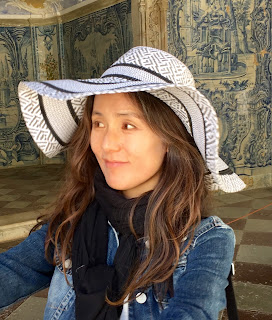 |
| Hope Lim, Author |
Time for eight fun rapid-fire questions.
Describe yourself in five words.
Optimistic, creative, thoughtful, sensitive, and idealistic.
What item displayed on your desk gives you inspiration?
Stacks of books I want to read.
What is your favorite childhood memory?
Climbing the mountains behind my parent’s house and catching dragonflies.
Sunrise or sunset?
Sunset. Only because I see it more often and I love the colors.
When are you most productive?
At night when the house is quiet, and I am the only one who is awake.
Riding bikes or jogging?
Jogging. I run every day!
What surprises you?
People who are not kind.
Favorite place to be.
A place with people who have known me for years.
And now for some writing advice from Hope:
My general advice is read and write and read and write. Reading nourishes your mind and writing strengthens your ability and helps you find your own voice. Writing is hard but we all know what it is like to experience that rare Ah Ha moment that makes our story sing. That blissful moment makes us feel alive and can come to us when we spend lots of time with our stories by writing and reading and thinking about them.
One specific piece of advice is to make a dummy to see the pacing of your story and how the page turns will work. Making a dummy is my favorite stage because I can envision it as a final product and often draw rough sketches along with text.
Thank you, Hope. The kidlit community looks forward to celebrating the release of Mommy’s Hometown on April 12th. It’s always a pleasure to have you on the GROG Blog.
For more information about Hope and her books visit her website.
Wednesday, March 2, 2022
Writing Work-for-Hire by Tina Cho
New book alert: My work-for-hire chapter book, Asian American Women in Science: 15 Inspiring People You Should Know, published with Rockridge Press, an imprint of Callisto Media, yesterday, March 1st, right on time for Women’s History Month!
As I begged, politely asked, people to review
it, some asked what work-for-hire means, so I thought I’d explain.
A work-for-hire book is one in which a publisher, most
often an educational publisher, finds writers to write books on a quick time
table, according to an idea usually thought up by the publisher, and in which
the copyright is in the publisher’s name. So that means they will pay the
writer a one-time, agreed upon amount. The writer will not receive any more
funds, no matter how well or poorly the book sells. Also, since the copyright
is in the publisher’s name, they can do whatever they want with the book. The writer
is giving them all rights to his/her work.
Pros of work-for-hire:
· quick
turn-around in getting books published
· sometimes
faster payment for your writing
· a
nice side gig if you want to earn some money (paying for child’s college, hehe)
· a
good way to add to your writing resume
· a
great way to get into the writing business working with an editor
Cons of work-for-hire
· one
payment, no matter how well the book does
· giving
up rights
· fast
turn-around of manuscripts, meaning it can be stressful doing lots of research
and writing in a short amount of time
My experience
I started writing in 2008 for the educational,
work-for-hire market. Most of you know, I’m an elementary teacher and still am.
You can see my work-for-hire projects here. Lately, I
haven’t pursued projects, but rather clients come to me. If I have time, I’ll
accept.
The summer of 2021, an acquisitions editor from
Rockridge Press emailed me. She had seen my bio in SCBWI and of course, my
website. (Another reason to keep those bios current!). She asked if I was
interested in this project—Asian American Women in Science. I was interested in
the topic, but because it was so close to school starting, I wasn’t sure I
could dedicate enough time to research. The editor said if I was interested I’d
need to do a writing sample test on one of the women. So I thought, ok. If it’s
meant to be, then…if not, that’s my answer. Well, it so happened, the editor
chose me, out of the others in the running. So I prayed and told God, if He
wanted me to write this book, He would have to help me. School was starting
soon, and I had a daughter to move in to college.
So from July 26-Sept. 10, I was extremely busy writing 15 biographies, basically every two weeks, five stories were due. I paced on my calendar about how many days to write for each lady. I bought a new notebook (it’s the little fun things that count!) and added tabs for each scientist. I got into a groove of research and writing up my stories. The hardest part was finding enough information on some of the scientists. I wish I could’ve done interviews with those who are still living, but when I tried to contact them, there was no response. Or, I was told not to.
What I learned:
· I
can write a chapter book of 15 biographies in a short amount of time.
· Check
You Tube for interviews of your source.
· Be
activists. I was amazed by the women still living and carrying out their mission.
At the time of the writing, one of the women, Alice Min Soo Chun, was back in
Haiti, carrying out her mission because they had just had another earthquake.
· Women
are unstoppable. We leave legacies for our children. They are watching us, even
if we think they aren’t.
· Never underestimate yourself and what you can do with your writing!
So maybe you’re thinking, I’m interested in doing
work-for-hire. What are the next steps?
· Here is a work-for-hire writing course from my author friend, Annette Whipple. Annette is graciously offering a discount: code KIDLIT25 for 25% off any of our courses
· And
here’s a handout from SCBWI.
· Or
you can jump in yourself. Go to the library and find the children’s nonfiction
shelves. Write down the publishers, check the copyright. Look at the publishers’
websites and how to submit ideas or a sample packet.
For more information, see my posts here.
There are all kinds of work-for-hire writing
assignments. Besides nonfiction, my husband and I translate and proofread
Korean books for Tuttle Publishing. I’ve written guided reading books for
schools, lesson plans, reading passages, devotions, and stories for magazines.
There’s a whole world of writing out there waiting for
you to explore. Have fun!
 Tina Cho is the author of four picture books with 2 more unannounced-- Rice from Heaven: The Secret Mission to Feed North Koreans (Little Bee Books 2018), Korean Celebrations (Tuttle 2019), My Breakfast with Jesus: Worshipping God around the World (Harvest House 2020), and The Ocean Calls: A Haenyeo Mermaid Story (Kokila/Penguin Random House 2020). Her lyrical middle grade graphic novel, The Other Side of Tomorrow, debuts from Harper Alley in 2024. After living in South Korea for ten years, Tina, her husband, and two teenagers reside in Iowa where Tina also teaches kindergarten.
Tina Cho is the author of four picture books with 2 more unannounced-- Rice from Heaven: The Secret Mission to Feed North Koreans (Little Bee Books 2018), Korean Celebrations (Tuttle 2019), My Breakfast with Jesus: Worshipping God around the World (Harvest House 2020), and The Ocean Calls: A Haenyeo Mermaid Story (Kokila/Penguin Random House 2020). Her lyrical middle grade graphic novel, The Other Side of Tomorrow, debuts from Harper Alley in 2024. After living in South Korea for ten years, Tina, her husband, and two teenagers reside in Iowa where Tina also teaches kindergarten. 







